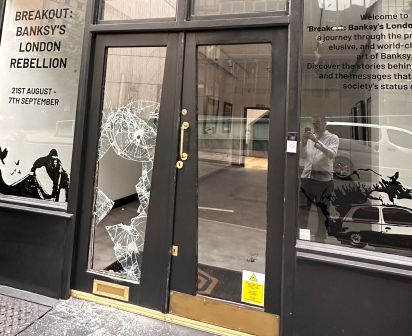The art world, often associated with creativity and cultural enrichment, is facing a growing challenge in the form of rising art crime. In recent months, London’s prestigious galleries and private collectors have been targeted by art thieves, prompting the implementation of stringent security measures. These changes are reshaping how galleries operate and how the art industry ensures the safety of its invaluable pieces.
A Surge in Art Thefts
The most high-profile incident in recent memory involved the theft of Banksy’s iconic “Girl with Balloon” from Grove Square Gallery. This audacious heist has underscored the vulnerabilities within the art sector. Art crime has surged globally, with stolen pieces often being used as collateral in illicit activities or trafficked through underground markets. London, as a major hub for the art world, has found itself at the epicenter of this alarming trend.
According to the Art Loss Register, art theft has seen a significant uptick in 2024, driven by both the high valuation of artworks and the relative ease with which thieves can exploit gaps in gallery security. These crimes are often orchestrated by sophisticated networks, making recovery efforts challenging and time-consuming.
Heightened Security Measures
In response to these threats, London galleries are adopting new protocols to safeguard their collections. For private viewings, identity checks are now a standard practice. This ensures that prospective buyers or visitors can be traced if necessary. Additionally, buyers—particularly those dealing with high-value works—are often accompanied by security guards to prevent on-site incidents.
Another notable measure includes the integration of advanced technology. Many galleries are investing in biometric systems, high-definition surveillance cameras, and motion-detection alarms. These systems are designed to deter potential thieves and provide crucial evidence in case of theft.
The art market’s response isn’t limited to galleries. Art insurance companies have started offering bespoke packages that cover theft, damage, and fraud. These packages are tailored to address the specific needs of galleries and collectors, ensuring that their investments are protected.
In addition to physical security measures, galleries are now collaborating more closely with law enforcement agencies and private security firms. This cooperation includes sharing intelligence about potential threats and developing rapid response protocols for incidents. For example, some galleries have instituted emergency drills to ensure staff are prepared to handle thefts or other security breaches effectively.
Money Laundering and Regulatory Challenges
Art crime isn’t limited to theft. The industry has long been a target for money laundering, especially in the wake of sanctions imposed on Russian oligarchs and other high-net-worth individuals. The UK’s National Crime Agency (NCA) has called for increased vigilance within the art market, urging galleries and auction houses to adhere strictly to anti-money laundering (AML) regulations.
This includes conducting thorough due diligence on clients and maintaining transparent records of transactions. Compliance with AML laws not only protects galleries from legal repercussions but also preserves the integrity of the art market.
Moreover, galleries are under increasing pressure to adopt more robust provenance checks to ensure that artworks are not linked to illicit activities. These checks involve tracing the ownership history of artworks and verifying their authenticity. While time-consuming, these measures are essential in building trust within the art market.
Implications for the Art World
While these security measures are necessary, they also pose challenges for galleries and collectors. Increased costs associated with security and compliance may limit access to certain works or discourage smaller galleries from participating in high-profile exhibitions. Moreover, the heightened scrutiny may deter some buyers who value discretion in their purchases.
However, the art world has a responsibility to adapt to these evolving threats. By fostering collaboration among galleries, law enforcement, and security experts, the industry can create a safer environment for both artists and collectors. Moreover, raising awareness about the risks and consequences of art crime can help deter potential offenders.
Public education campaigns also play a role in reducing demand for stolen art. By highlighting the ethical and legal issues associated with purchasing stolen works, galleries and advocacy groups can help discourage the illicit trade of stolen pieces.
The Path Forward
London’s art scene is resilient, and its response to the rise in art crime demonstrates the industry’s commitment to protecting its cultural treasures. As technology continues to advance, so too will the methods used to safeguard artworks. The art world’s ability to adapt and innovate will be key to overcoming these challenges, ensuring that creativity and cultural heritage remain at the forefront of the industry.
For now, the message is clear: while art may be priceless, its protection comes at a cost that the industry is willing to bear. By combining traditional security measures with cutting-edge technology and fostering a culture of vigilance, the art world can rise to meet these challenges head-on. The ongoing fight against art crime is not just about protecting objects but also preserving the cultural and historical narratives they represent.























